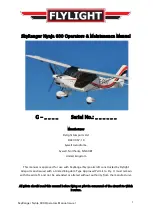
Pilot's Operating Handbook
Section 2
Limitations
EASA Approved
Edition 0 - March 05, 2019
Rev. 0
Page 2.6.10
Icing conditions
Except for certain phases of flight where the POH specifies that deicing boots should
not be used (e.g. take-off, final approach, and landing), compliance with the following
is required.
Wing and Tail Leading Edge Pneumatic Deicing Boot System must be activated:
-
At the first sign of ice formation anywhere on the aircraft, and
-
The system must either be continued to be operated in the automatic cycling
mode, if available; or the system must be manually cycled as needed to
minimize the ice accretions on the airframe.
The wing and tail leading edge pneumatic deicing boot system may be deactivated
only after leaving icing conditions and after the airplane is determined to be clear of
ice.
The Ice Detection System is only an advisory system. The pilot must activate
manually the ice protection systems as a preventive prior to entering icing conditions
or when icing conditions are identified.
In any case of icing conditions, first refer to Particular procedures described in
chapter 4.5 and in case of unforeseen icing conditions, refer in addition to the
Emergency procedure described in chapter 3.12.
Severe icing conditions
▲
WARNING
▲
Severe icing may result from environmental conditions outside of
those for which the airplane is certificated. Flight in freezing rain,
freezing drizzle, or mixed icing conditions (supercooled liquid
water and ice crystals) may result in ice build-up on protected
surfaces exceeding the capability of the ice protection system, or
may result in ice forming aft of the protected surfaces. This ice
may not be shed using the ice protection systems, and may
seriously degrade the performance and controllability of the
airplane.
▲
PIM - DO NOT USE FOR FLIGHT OPERATIONS











































